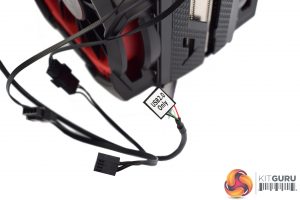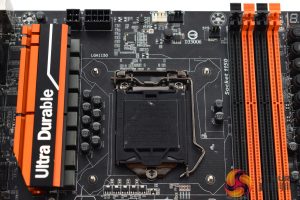
MSI is probably not a company you typically associate with high-end air coolers, but it is exactly that market MSI is trying to break into with its new Core Frozr XL. The Frozr XL is a monstrous, 8-heatpipe behemoth of an air cooler that also sports integrated RGB lighting as well as adjustable fan positioning to cater to those with tall memory modules. Could this be your next air cooler?
While we do not have a confirmed UK price yet, as the Core Frozr XL won't land on these shores until later in Q3, MSI told us to expect pricing to be in the region of £80. With that in mind, the Frozr XL faces stiff competition from the likes of the Cryorig R1 Ultimate, the Cooler Master MasterAir Maker 8 and even the FSP Windale 6. Can it do enough to impress?
Specification
- Model Name: Core Frozr XL
- Dimension with fans (mm): 150.4 mm x 170.0 mm x 129.8 mm (DxHxW)
- Weight: 1295 g (w/ Dual Fans)
- Socket Intel: LGA 2066/LGA 2011-3/2011/1366/1156/1155/1151/1150/775
- Socket AMD: AM4/FM2/FM1/AM3+/AM3/AM2+/AM2
- Bearing Type: Hydro-Dynamic Bearing
- Rated Speed: 500 – 1800 ±15% RPM
- Air Flow: 19.79 – 71.27 CFM
- Static Air Pressure: 0.16 – 2.09 mm-H20
- Noise Level (Fans): 17.2 ~ 33.6 dBA
- Connector: 4-Pin PWM/DC
- Life Expectancy: MTTF 150,000 Hours (25℃)
- Thermal Grease: Premium thermal compound X
The MSI Core Frozr XL ships in a dark box with a large product photo on the front.
Inside, all of the installation hardware comes immaculately presented in a padded box – I love this as it creates an excellent first impression and oozes class.
The only other included accessory is the small paper manual.
The cooler itself is a very chunky unit, measuring 150.4 mm x 170.0 mm x 129.8 mm (DxHxW) with both fans attached – which, incidentally, is how it comes out-of-the-box. The fans do attach using two clips on either side, though, so it is easy to remove one or both units.
The fans also sport some red plastic housing, giving the cooler its red-and-black colour scheme, an MSI classic.
At the base of the cooler we get a look at the 8x 6mm-thick nickel-plated heatpipes – which is some serious cooling power.
It also worth mentioning that the cooler uses a standard 4-pin PWM cable for its two fans (a splitter cable is included), but if you want to utilise the RGB lighting you will need a spare USB header on your motherboard.Here I will walk you through the installation process. It is worth noting we test using a Z97 motherboard – socket LGA 1150. The process below reflects that.
First of all, prepare the backplate by passing four screws through the Intel LGA 115x mounting holes. A plastic washer is placed over each screw to keep them in-place.
Next, go ahead and place the backplate behind the motherboard's socket area so the screws come through the four socket holes.
After that, four large nuts can be attached to the backplate screws.
With that done, you can place the metal mounting bracket on-top of the nuts before securing it with four small screws.
Now it's time to apply thermal paste and mount the cooler. The cooler's mounting bar should align with the two screw holes on the bracket we just installed.
When you've got everything lined up, use the last two screws to lock the cooler down.
With that done, installation is complete. Overall, it is very conventional and simple process so no complaints from me.
It is also worth pointing out that the fans can be re-positioned higher up the heatsink to allow for use of memory modules up to 55mm tall. You can see my Corsair Vengeance DDR3 fits no problem, even in the furthest DIMM slot, with the fan raised slightly.
The RGB lighting is worth touching on, too. By default, the MSI dragon cycles through the colour spectrum but if you download the Mystic Light utility, you can customise the lighting – choosing from effects including ‘breathing', ‘random' and ‘rainbow'.
If you have a MSI Mystic Light-compatible motherboard you can also synchronise the lighting that way, too.To test all CPU coolers, we devised an easily repeatable test with no variables other than the coolers themselves. This ensures that figures from every cooler we test are comparable with each other.
Test rig
Using an open-air test bench, we deploy an Intel Core i7-4790K plugged into a Gigabyte Z97X-SOC Force motherboard. Alongside this is 16GB of 2400MHz Corsair Vengeance DDR3, as well as a 120GB OCZ Trion 150 SSD. Powering everything is a Corsair RM750x PSU.
The test process
Testing coolers involves taking a total of 4 temperature readings per cooler. First, we measure the idle temperature of the i7-4790K at stock speeds (turbo boost disabled), before measuring its temperature under load at stock speeds. Next, we overclock the CPU to 4.5GHz using a 1.3 Vcore, ensuring greater heat output. In its overclocked state we then measure the idle and load temperatures of the CPU again. The figures we present are temperature deltas – meaning we take each temperature reading and minus the ambient temperature from it. This allows us to test in an environment that is not temperature-controlled.
To ward off potential comments or questions, we know 4.5GHz using a 1.3 Vcore is not the ‘best’ overclock – this particular CPU could reach that frequency at closer to 1.25 on the Vcore, which is more efficient. That is not the point, however. We are trying to stress the coolers to see how they deal with excess heat … hence the higher than necessary Vcore.
Where possible, each cooler’s fans are plugged directly into the motherboard using the CPU_Fan or CPU_Opt headers. Some AIOs, however, ship with their own fan controllers or PWM hubs. If we are unable to plug the fans directly into the motherboard, it is specified in the performance section of the review.
An idle reading comes from leaving Windows on the desktop for 15 minutes. A load reading comes from running Prime95’s (version 26.6) Small FFTs test for 15 minutes – enough time for temperatures to plateau.
Noise output
Unfortunately I am unable to accurately measure the sound output of CPU coolers using a digital sound meter. This is because I am based alongside a busy road (with high ambient noise levels). Using a sound meter is, as such, not possible as there are variables out of my control. However, I will try my best to subjectively describe the noise output in a helpful manner.Temperatures
All temperature charts are sorted with lowest load temperatures at the top.
As you can see above, performance of the Frozr XL is actually quite middling. It does perform a bit better with an overclocked CPU, but even so, I would've thought that its 8 heatpipes, and two fans, might have helped temperatures a bit more.
It is still far from bad, though – after all, it is only 4 degrees behind our top-performing air cooler, the Cryorig R1 Ultimate, but even so, the Cryorig H7 is smaller and cheaper while still proving to be a better performer.
Acoustics
The Frozr XL's noise levels are good, however. With the CPU idling I couldn't hear the fans, and when under load the noise is still not much of a racket. This is with the cooler next to me using an open-air test bed, too – in a case, the noise would be frankly negligible.On the whole, the MSI Core Frozr XL is a capable air cooler that does a lot right.
For one, it is very easy to install and you will be up and running in minutes. I also like the ability to re-position the fans to allow for greater memory support, as you can actually use modules up to 55mm tall and still have fans either side of the heatsink.
I do think the cooler aesthetics could split opinion, though, as MSI has opted for a classic black and red ‘gamer' colour scheme. I personally think it looks good, but this cooler isn't particularly subtle.
On that note, though, I do have to question the inclusion of the RGB lighting – to my mind, having the black and red colour scheme defeats the point of RGB lighting, as there is already a preset colour scheme you can't control. In that sense, I can't help but feel the RGB lighting is a bit redundant. A more neutral design would've helped the RGB lighting feel a bit more useful.
In terms of its performance, the Frozr XL is not bad at all. It isn't the best air cooler we've seen – the Cryorig H7 actually beat it out, despite its size deficit – but it is just fine and won't cause you any thermal issues. Its fans are also nice and quiet, something we always appreciate.
So, overall, the MSI Core Frozr XL is definitely a good product. It doesn't blow us away, but it does the job and will likely appeal strongly to those with other MSI products, or if you simply have a black and red colour scheme and are looking for a complimentary cooler.
We are still waiting for the Frozr XL to launch in the UK but we have been told to expect pricing to be around the £80 mark.
Discuss on our Facebook page, over HERE.
Pros
- Excellent presentation.
- Fans can be moved to allow memory modules up to 55mm tall.
- Decent performance.
- Nice and quiet.
- Subjectively good-looking.
Cons
- The ‘gamer-y' styling may not appeal to everyone.
- RGB lighting feels a bit redundant given the black and red colour scheme.
- Not the best performing air cooler we've ever seen.
KitGuru says: It may not be a hands-down killer air cooler, but the MSI Frozr XL is easy to install, performs well and is pretty quiet, too.
 KitGuru KitGuru.net – Tech News | Hardware News | Hardware Reviews | IOS | Mobile | Gaming | Graphics Cards
KitGuru KitGuru.net – Tech News | Hardware News | Hardware Reviews | IOS | Mobile | Gaming | Graphics Cards



























Great first cooler from MSI I am very impressed
MSI’s second actually. The first is the Core Frozr L, which performed rather well. https://www.msi.com/Graphics-card/CORE-FROZR-L.html
Products168
Still nothing to switch the Dark Rock for
perfecto, me parece siendo gratis que quieres jaja